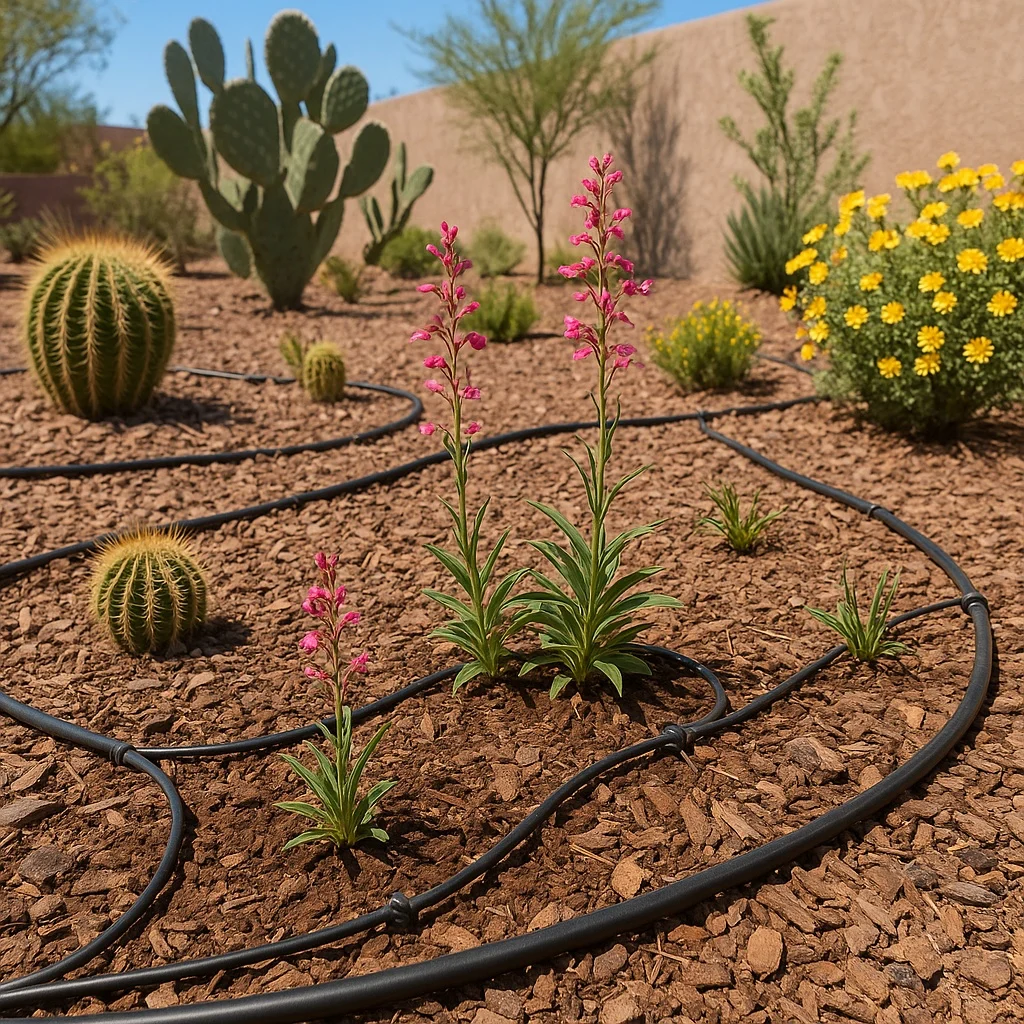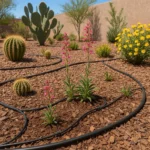Drip irrigation is a game-changer for keeping your Gilbert yard lush and thriving while minimizing water waste. But simply installing a drip system isn’t enough to maximize its potential. With a few smart tweaks and regular maintenance, you can take your drip irrigation to the next level for healthier plants and lower water bills.

Optimize Emitter Placement and Flow
The key to drip efficiency is delivering water directly to the root zone of each plant. Take time to carefully position each emitter 6-12 inches from the base of the plant, ensuring water reaches the roots while minimizing evaporation and runoff. Inspect emitters regularly and adjust any that have shifted out of place.
It’s also crucial to provide the right amount of water flow for each plant’s needs. Use adjustable emitters or multiple emitters for larger shrubs and trees that require more water. Avoid a “one-size-fits-all” approach, as this can lead to both overwatering and underwatering issues.
For densely planted areas like vegetable gardens or flower beds, consider upgrading to inline drip tubing with pre-installed emitters at regular intervals. This ensures even water distribution without the hassle of placing individual emitters.
Maintain Your System to Prevent Problems
Over time, drip lines can develop clogs from mineral buildup or algae growth, reducing water flow to your plants. Flush your system at the start of each growing season by removing the end caps and letting water run freely for a few minutes. This clears out any accumulated debris.
Inspect lines, emitters, and connections monthly for signs of leaks, clogs, or damage. Promptly replace any faulty components to keep your system running smoothly. Installing a filter at the water source can minimize debris and extend the life of your drip components.
As plants grow and mature, adjust your drip lines to accommodate their expanding root zones. Failing to “grow” your drip system with your plants can lead to insufficient watering and stunted growth. Don’t be afraid to add or relocate emitters as needed.
Dial In Your Watering Schedule
While drip irrigation is inherently more efficient than sprinklers, you can still overwater if your system runs too long or too often. Familiarize yourself with the unique watering needs of each plant type in your yard, factoring in soil type and sun exposure.
In general, deep, infrequent watering is better than short daily sessions. This encourages deeper root growth and drought resilience. Aim to water long enough to moisten soil to a depth of 6-12 inches, then let it dry out moderately before watering again. Avoid overwatering in May when temperatures rise but plants aren’t yet in peak summer growth.
Consider upgrading to a smart irrigation controller that automatically adjusts run times based on local weather data and soil moisture sensors. This takes the guesswork out of scheduling and ensures your plants get exactly what they need, no more and no less.
Give Potted Plants Special Attention
Drip irrigation is a lifesaver for keeping potted plants thriving in Gilbert’s intense heat. However, pots dry out much faster than in-ground plants and may need water daily during summer. Use multiple emitters and consider incorporating a pot reservoir system to provide a steady water supply.
Monitor potted plants closely for signs of stress and adjust your drip schedule as needed. Applying a layer of mulch to the soil surface can help retain moisture and regulate soil temperature. With attentive care, your container gardens can flourish all season long.
Timing Matters, Especially in Summer
While evening watering is often recommended to minimize evaporation, it can sometimes promote fungal growth in humid conditions. In Gilbert, the best time to run drip irrigation is typically in the early morning hours just before sunrise. This gives plants a good drink to start the day while allowing excess surface moisture to evaporate.
As summer temperatures soar, your plants may need a second shorter drip session in the late afternoon to maintain consistent soil moisture. Just be sure to allow enough time for leaves to dry before nightfall. Experiment and observe your plants to find the optimal summer drip schedule.
By following these pro tips for maximizing drip irrigation efficiency, you’ll keep your Gilbert landscape vibrant and water-wise all year long. A little extra attention to your drip system pays off in healthier plants, easier maintenance, and a more sustainable yard.

